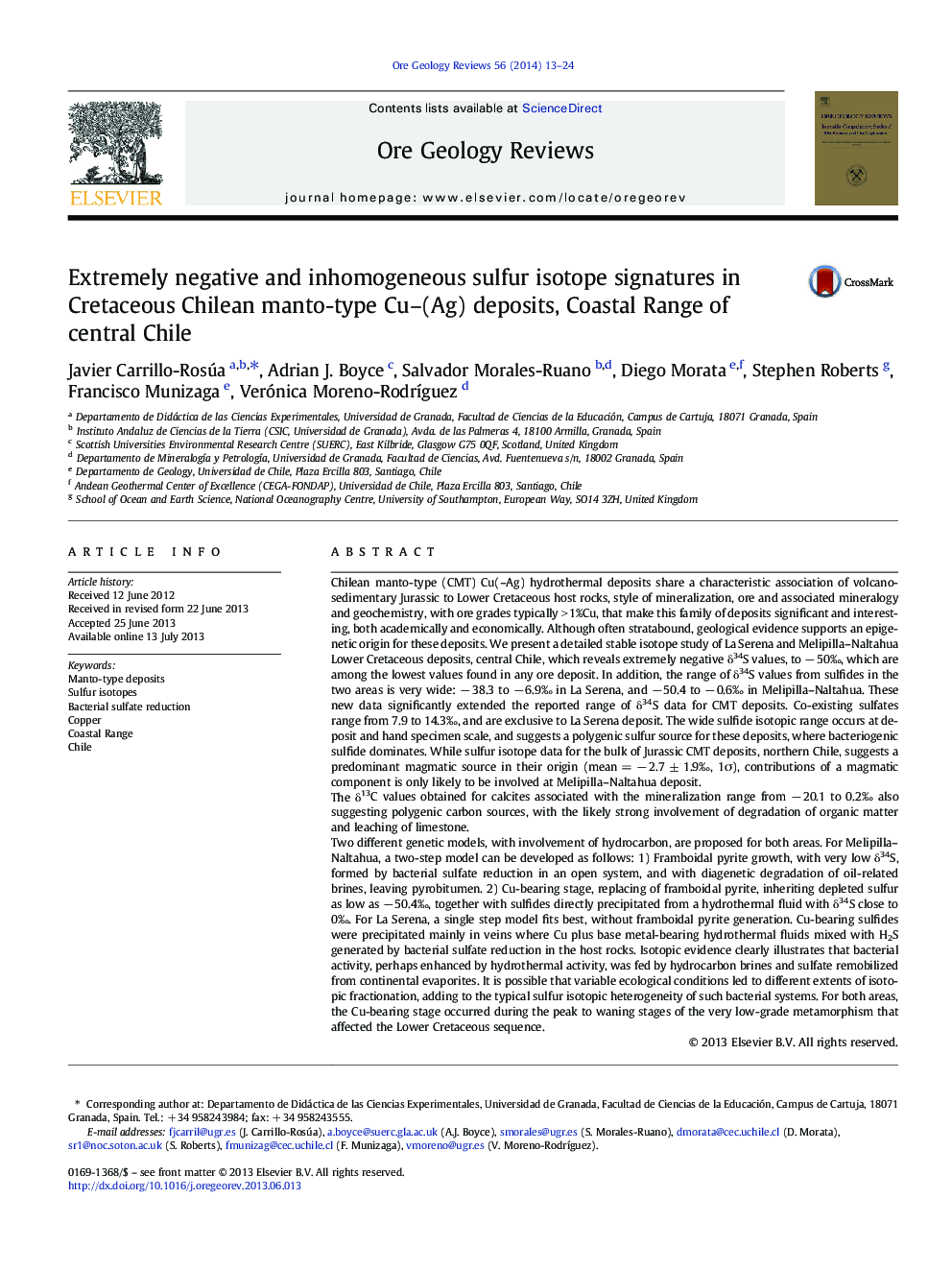| کد مقاله | کد نشریه | سال انتشار | مقاله انگلیسی | نسخه تمام متن |
|---|---|---|---|---|
| 4697420 | 1637247 | 2014 | 12 صفحه PDF | دانلود رایگان |

• Chilean manto-type (CMT) Cu(–Ag) deposits are hosted in volcano-sedimentary rocks.
• CMT deposits show δ34S values to − 50‰, among the lowest found in any ore deposit.
• δ34S range for overall CMT deposits are among the broadest in any ore mineralization.
• Bacterial sulfate reduction is involved in the majority of Cretaceous CMT deposits.
• Different specific genetic models are applicable to individual deposits.
Chilean manto-type (CMT) Cu(–Ag) hydrothermal deposits share a characteristic association of volcano-sedimentary Jurassic to Lower Cretaceous host rocks, style of mineralization, ore and associated mineralogy and geochemistry, with ore grades typically > 1%Cu, that make this family of deposits significant and interesting, both academically and economically. Although often stratabound, geological evidence supports an epigenetic origin for these deposits. We present a detailed stable isotope study of La Serena and Melipilla–Naltahua Lower Cretaceous deposits, central Chile, which reveals extremely negative δ34S values, to − 50‰, which are among the lowest values found in any ore deposit. In addition, the range of δ34S values from sulfides in the two areas is very wide: − 38.3 to − 6.9‰ in La Serena, and − 50.4 to − 0.6‰ in Melipilla–Naltahua. These new data significantly extended the reported range of δ34S data for CMT deposits. Co-existing sulfates range from 7.9 to 14.3‰, and are exclusive to La Serena deposit. The wide sulfide isotopic range occurs at deposit and hand specimen scale, and suggests a polygenic sulfur source for these deposits, where bacteriogenic sulfide dominates. While sulfur isotope data for the bulk of Jurassic CMT deposits, northern Chile, suggests a predominant magmatic source in their origin (mean = − 2.7 ± 1.9‰, 1σ), contributions of a magmatic component is only likely to be involved at Melipilla–Naltahua deposit.The δ13C values obtained for calcites associated with the mineralization range from − 20.1 to 0.2‰ also suggesting polygenic carbon sources, with the likely strong involvement of degradation of organic matter and leaching of limestone.Two different genetic models, with involvement of hydrocarbon, are proposed for both areas. For Melipilla–Naltahua, a two-step model can be developed as follows: 1) Framboidal pyrite growth, with very low δ34S, formed by bacterial sulfate reduction in an open system, and with diagenetic degradation of oil-related brines, leaving pyrobitumen. 2) Cu-bearing stage, replacing of framboidal pyrite, inheriting depleted sulfur as low as − 50.4‰, together with sulfides directly precipitated from a hydrothermal fluid with δ34S close to 0‰. For La Serena, a single step model fits best, without framboidal pyrite generation. Cu-bearing sulfides were precipitated mainly in veins where Cu plus base metal-bearing hydrothermal fluids mixed with H2S generated by bacterial sulfate reduction in the host rocks. Isotopic evidence clearly illustrates that bacterial activity, perhaps enhanced by hydrothermal activity, was fed by hydrocarbon brines and sulfate remobilized from continental evaporites. It is possible that variable ecological conditions led to different extents of isotopic fractionation, adding to the typical sulfur isotopic heterogeneity of such bacterial systems. For both areas, the Cu-bearing stage occurred during the peak to waning stages of the very low-grade metamorphism that affected the Lower Cretaceous sequence.
Journal: Ore Geology Reviews - Volume 56, January 2014, Pages 13–24